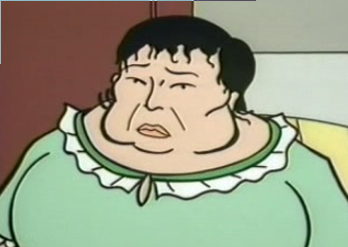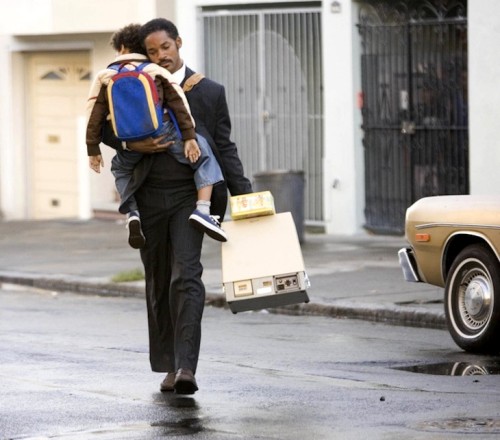This guest post by Maggie Slutzker appears as part of our theme week on Fatphobia and Fat Positivity.
Daria might be my favorite show in the entire world. In the last two years, I’ve watched the series straight through at least four times. I love almost everything about it— the way Quinn pimps high school boys, Ms. Barch’s misandry, Mr. DiMartino’s dry sarcasm, and everything about Jodie Landon. Helen Morgendorffer is my idol, and I long to spend a weekend with the Lane family. Most of all though, I love Daria and Jane’s friendship and how it survives every obstacle it encounters. Daria is the only show that makes me laugh, motivates me, and reminds me to appreciate my friends and family, all at the same time. But, since the very first time I viewed the series, there has always been one thing that made me uncomfortable. Through its five seasons, Daria was able to tackle so many issues with grace—being ditched by your best friend, alienation by your peers, sexism, racism, elitism, marriage, the true tedium of high school, and douchebag boyfriends. So what isn’t on this list? Fatphobia.
There is one notably fat character on the show, but if you aren’t an obsessive watcher like I am, you may not remember her. Her name is Mrs. Johanssen, and she’s probably diabetic.
Mrs. Johansen never appears for very long, but she’s always a source of comic relief. We first meet her in a season one episode (“Cafe Disaffecto”) in which Daria and Jane are selling chocolate bars for a school fundraiser. She tells the girls she isn’t supposed to eat chocolate, but she’d like to buy some anyway. Then, she faints as a result of hypoglycemia and possibly exhaustion, the results of her being so large. Daria and Jane stand still for a moment, startled and clueless, and then Jane takes a picture. Mrs. Johansen wakes up and insists on buying every single chocolate bar they have. When Daria and Jane leave without selling them to her, Mrs. Johansen calls up legendary principal Angela Li and complains. When Ms. Li suggests that maybe Mrs. Johansen wanted the chocolate for her family, Jane says, “She has no family. She ate them.”
In her handful of appearances throughout the series, Mrs. Johansen is always depicted in a very specific way: short, messy hair; usually panting, sweating or having some sort of physical trouble; always wearing a muumuu; and of course, always obsessively pursuing some sort of food, whether chocolate bars or cheese logs. This is briefly explained in the episode “Psycho Therapy,” in which she is speaking with a psychologist about using food for comfort her parents didn’t provide. There is emotional trauma behind her fatness.
One of the great things about cartoons is that they have a unique opportunity to make characters of literally all shapes, sizes, and colors, and treat every single difference, no matter how bizarre, as completely normal. The fact that Skeeter from Doug was blue or that Arnold and Gerald from Hey Arnold! had some non-standard head-shapes were acknowledged, but in the end these features were only background to the real problems characters dealt with. Daria too never ignored a character’s appearance, from Brittany’s chest, to Trent’s tattoos, to Jodie’s Blackness and related struggle. The show was excellent at revealing new sides and dimensions to characters, and seemed to take pleasure in showing hidden strengths and weaknesses. Mr. DiMartino had a gambling addiction and a sensitive side, and vain Quinn turned out to be pretty clever and even kind. Daria was excellent at showing that there was always more to a person than an image or stereotype. So why make the only fat character utterly one-dimensional, more a device than a person?
It’s also interesting to me that a show so centered around teenage-hood barely seems to mention fatness, something most teen girls hear about constantly. Among Daria’s own struggles with body image, weight is never mentioned, though a lack of curvaceousness is. The only other characters who discuss weight and fatness in detail are, of course, the Fashion Club. The Fashion Club quartet are beloved to me, especially Quinn, whose developmental arc in the series is one of my favorites. But they are— and of course, they’re intended to be— problematic and ridiculously, hilariously superficial, and the episode about weight gain is no exception. The episode in question, “Fat Like Me,” begins with the Fashion Club deciding whether to set a weight limit for its members. Just minutes after the topic is introduced, club president Sandi Griffin falls down a flight of stairs and breaks her leg. She manages to stay out of school for several weeks, and when she returns…she is “fat.” (If we assume all members of the Fashion Club are under a size four, then I’m guessing “fat” means maybe a size seven or eight?) At Daria’s thinly veiled advisement, Quinn becomes Sandi’s coach after the weight gain threatens to destroy the Fashion Club, and Sandi loses the weight. For Sandi, a fat body is an obstacle to overcome.
In writing this, I don’t mean to say that you’re a bad person if you laughed when Mrs. Johansen and Mr. DiMartino faced off over free sample cheese logs. Nor do I mean to claim that there aren’t fat people who are unhealthy or even whose lives are threatened by a condition related to their weight. What I’m saying is that this is not the only way fat people exist. There are plenty of of healthy, happy, stylish people who are also overweight or obese. There are fat people who exercise, and there are fat people who aren’t obsessed with food. To put it plainly, fatness isn’t automatically a problem. But Mrs. Johansen embodies every negative fat stereotype there is. Her fatness is a medical condition, a consequence of excessive and unhealthy living as well as possible abuse. When Sandi gets fat, it is a result of forced inactivity and again, something that she and Quinn have to solve. When, at the end of the episode, Quinn suggests the Fashion Club ease up on weight limits, it is another suggestion that weight gain is a consequence of unfortunate circumstances, another implication that fatness is a problem to be pitied.
For Daria to indicate that fatness comes solely from inactivity and junk food is particularly frustrating because Daria herself adores junk food. There are frequent mentions of cheese fries, and pizza plays a pivotal role. She drinks soda. Quinn chides her for eating hamburgers, chocolate cake (for breakfast), and a cartoon version of Pop Tarts. Quinn herself is an embodiment of popular beauty standards— one of her first priorities is “bouncy hair,” and though boys are constantly fetching her soda, we’re pretty sure that it’s diet. The show repeatedly uses Quinn and the Fashion Club to poke fun at all things superficial, and Daria to expose the hypocrisy behind the messages we send teenagers and consumers. But while Daria doesn’t diet, rarely puts on makeup, and never lets fashion dictate her wardrobe, she also never gets fat. So why the automatic connection between fat and food when the TV show itself acknowledges that skinny people can easily love and eat junk food?
Now, Daria may be a slightly older program, but its narrow depiction of fat characters is part of a problem we’re still dealing with today. It is rare to see a fat character whose fatness isn’t made into comic relief (think Bridesmaids), an embarrassing history (Schmidt from New Girl), or some sort of terrible consequence (Precious). It is nearly always a negative, something to be pitied. Daria strived to point out that nothing is perfect, not all is as it seems, and everyone is vulnerable. But sadly, for a show so determined to point out the absurdities of societal expectation, Daria really didn’t shed any light on fatphobia other than to contribute to it.
Maggie Slutzker is a writer, feminist, and fervent Daria fan. You can follow her on Twitter @SuchaSlutzker.













